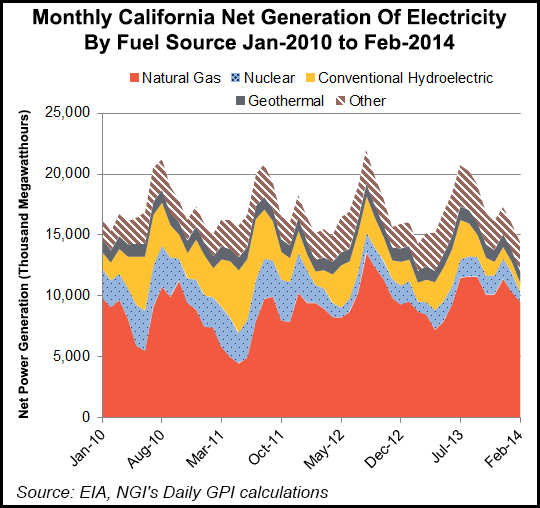Markets | Infrastructure | NGI All News Access | NGI The Weekly Gas Market Report
With Less Hydro, California to Lean More Heavily on Gas-Fueled Power
A major drought, loss of a major nuclear power plant, and increased reliance on intermittent renewable power shouldn’t phase California’s grid this summer, according to a new report. Gas-fired power can step in, but with some caveats.

Adequate power supplies are available to meet summer peak demand conditions with the help of a natural gas-fired power plant network, which faces some uncertainty, according to the report released last Friday by the California Independent System Operator (CAISO).
Since last summer, California has gotten a net increase in generating capacity of 3,243 MW, 68% of which is renewables’ the rest comes from added gas-fired generation, said CAISO, adding that supplies are sufficient “for meeting summer peak conditions across the state despite well below-average hydroelectric supply.”
“Sufficient flexible resources will need to be maintained on the system to be able to successfully integrate the increasing levels of renewables,” the CAISO 2014 Summer Assessment said. “This will be particularly challenging in light of the remaining 10,517 MW of gas-fired generation capacity that is subject to once-through-cooling regulations requiring that this capacity be retired.”
Some repowering and retrofitting of the gas plants is scheduled to be done by the end of 2017, with the rest completed by 2020, the report said.
“The main impact from the drought during the 2014 summer will be an increase in natural gas generation, which could result in an increase in energy prices, and increased greenhouse gas emissions,” the report said. Among the state’s 260 thermal power plants bigger than 20 MW, three in Northern California totaling 1,150 MW are at risk for having their water supplies curtailed.
For proprietary reasons Pacific Gas and Electric Co. (PG&E) wouldn’t offer specifics about its projections for its own electricity supplies, but a San Francisco-based spokesperson did confirm that the continuing drought means there will be less hydroelectric power.
“With the near-historically low levels of precipitation in 2013-2014, PG&E is working hard to conserve water in its reservoirs so hydropower will still be available during peak-demand periods of summer,” the spokesperson said.
On the natural gas side, the combination utility is seeking to inject more gas into its underground storage facilities to cover power generation needs this summer and to get ready for next winter’s gas heating loads, the spokesperson told NGI late last Friday.
PG&E reported that its working gas inventory on May 1 was 44.1 Bcf for its 105 Bcf capacity underground storage system. By comparison, last year on May 1, the working gas in storage was 84.2 Bcf, thee PG&E spokesperson said.
“For May, we have been averaging about 400 MMcf/d of injection.” On the overall system, including several major merchant storage fields. PG&E has about 260 Bcf of storage capacity connected to its gas system. More recently, the utility’s published working gas inventory was up to 46.8 Bcf on May 6.
Sempra Energy’s Southern California Gas Co., which like PG&E has more than 100 Bcf of working storage capacity at four underground storage sites, through a Los Angeles-based spokesperson said it does not have a summer forecast on storage at this time.
“Storage levels in the [summer] in 2013 were unusually high, about 120 Bcf, on average,” the spokesperson told NGI on Monday. “Storage levels in the third quarter this year will be much lower than that.”
Both CAISO and PG&E confirmed the drought’s impact on water levels, noting precipitation was at 56% as of April 29, but snowpack water content was only 20% of average for the date and reservoir storage was at 63% of average for the late April date. CAISO’s report said to expect 1,370 to 1669 MW less from in-state hydro electric supplies this summer, although the out-of-state supplies should make up for that from the Pacific Northwest, which is above normal in the Columbia River Basin.
CAISO expects summer peak demand to top 47,000 MW this summer, a little above what it calls a “normalized peak” but well below its all-time record set in 2006 at 50,270 MW. The state grid operator expects to have nearly 54,000 MW of capacity (53,950 MW) available this summer, due to the renewables and gas-fired generation increases.
© 2024 Natural Gas Intelligence. All rights reserved.
ISSN © 1532-1231 | ISSN © 2577-9877 | ISSN © 1532-1266 |
